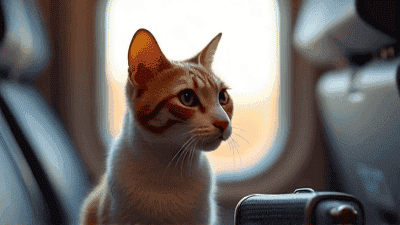
Traveling with a cat can be a challenging yet rewarding experience. Cats are creatures of habit who thrive in familiar environments, so venturing into new territory can be stressful for them. However, with proper preparation and a few essential tips, you can make the journey smooth and enjoyable for both you and your feline friend. Whether you’re planning a road trip, a flight, or even a train ride, this comprehensive guide will provide you with everything you need to know to ensure your cat’s comfort and safety during travel.
Cats are territorial animals who prefer routines and familiar surroundings. Changes in environment, sounds, and smells can cause anxiety and stress. Understanding your cat’s behavior and needs is the first step to making travel more manageable for them.
If your cat shows any of these signs during travel, it’s important to address their discomfort immediately.

Before embarking on any trip, schedule a visit to the vet to ensure your cat is healthy and up to date on vaccinations. Discuss your travel plans with the vet, and ask for advice on managing your cat’s stress during the journey. If your cat is prone to anxiety, your vet may recommend calming medications or natural remedies.
The carrier will be your cat’s safe space during travel, so it’s essential to make it as comfortable as possible. Start by introducing the carrier a few weeks before your trip:
If your cat is not used to traveling, start with short car rides to help them get accustomed to the motion and sounds. Gradually increase the duration of these trips to build their confidence.
Select a carrier that is spacious enough for your cat to stand, turn around, and lie down comfortably. Ensure it has proper ventilation and secure latches.

Bring enough of your cat’s regular food to last the entire trip, along with a collapsible bowl for feeding and hydration. Avoid introducing new foods, as this can cause digestive issues.
Portable litter boxes are perfect for travel. Pack a small bag of your cat’s usual litter to maintain consistency.
Familiar items like blankets, toys, and treats can help ease your cat’s anxiety.
Carry a copy of your cat’s vaccination records and any necessary health certificates, especially if you’re traveling across state or international borders.
Include basic supplies like bandages, antiseptic wipes, and any medications your cat may need.
Place the carrier in a stable position, either on the back seat or on the floor of the car. Secure it with a seat belt to prevent it from sliding during sudden stops.
To reduce the risk of motion sickness:
Plan for regular breaks to allow your cat to stretch, eat, and use the litter box. Always keep your cat on a leash or in a secure area to prevent them from escaping.

Each airline has specific rules regarding pet travel, including carrier dimensions, weight limits, and fees. Book your cat’s ticket in advance and confirm all requirements with the airline.
If possible, choose in-cabin travel, as the cargo hold can be stressful and unsafe for pets. Ensure your carrier meets the airline’s in-cabin requirements.
Be prepared to remove your cat from the carrier during security checks. Use a harness and leash to keep your cat secure while the carrier is screened.
Most trains and public transportation systems require pets to be in a secure carrier. Check the specific rules of your chosen mode of transport.
Traveling during off-peak hours can help minimize stress caused by noise and crowds. Cover the carrier with a light blanket to create a sense of security for your cat.
Research pet-friendly hotels in advance and confirm their policies. Some hotels may charge additional fees or have restrictions on pet size and breed.
Bring items from home, such as your cat’s bedding, toys, and litter box, to make the new space feel more familiar.
Inspect the room for potential hazards, such as open windows or accessible electrical cords. Keep your cat in the carrier or on a leash until they are comfortable in the new environment.
Different countries have varying regulations for pet entry, including quarantine rules, vaccination requirements, and health certifications. Start the process well in advance to ensure compliance.
Ensure your cat is microchipped and wears a collar with an ID tag that includes your contact information. This is especially important for international travel.
If your cat escapes during travel, act quickly. Contact local animal shelters, veterinary clinics, and use social media to spread the word. Having recent photos and a description of your cat can aid in their recovery.
Know the location of the nearest veterinary clinic at your destination. Carry a basic first aid kit and be prepared to handle minor injuries or illnesses.
Cats are highly sensitive to their owner’s emotions. Staying calm and composed can help reassure your cat during the journey.
Consider using pheromone sprays, calming collars, or natural remedies to reduce your cat’s anxiety.
Reward your cat with treats and praise when they remain calm during travel. This will reinforce positive behavior and make future trips easier.
Traveling with a cat requires careful planning and patience, but with the right approach, it can be a stress-free and enjoyable experience for both you and your feline companion. By understanding your cat’s needs, preparing in advance, and creating a comfortable environment, you can ensure their safety and well-being throughout the journey. Whether you’re heading out on a short road trip or embarking on an international adventure, these essential tips will help you and your cat make the most of your travels together.